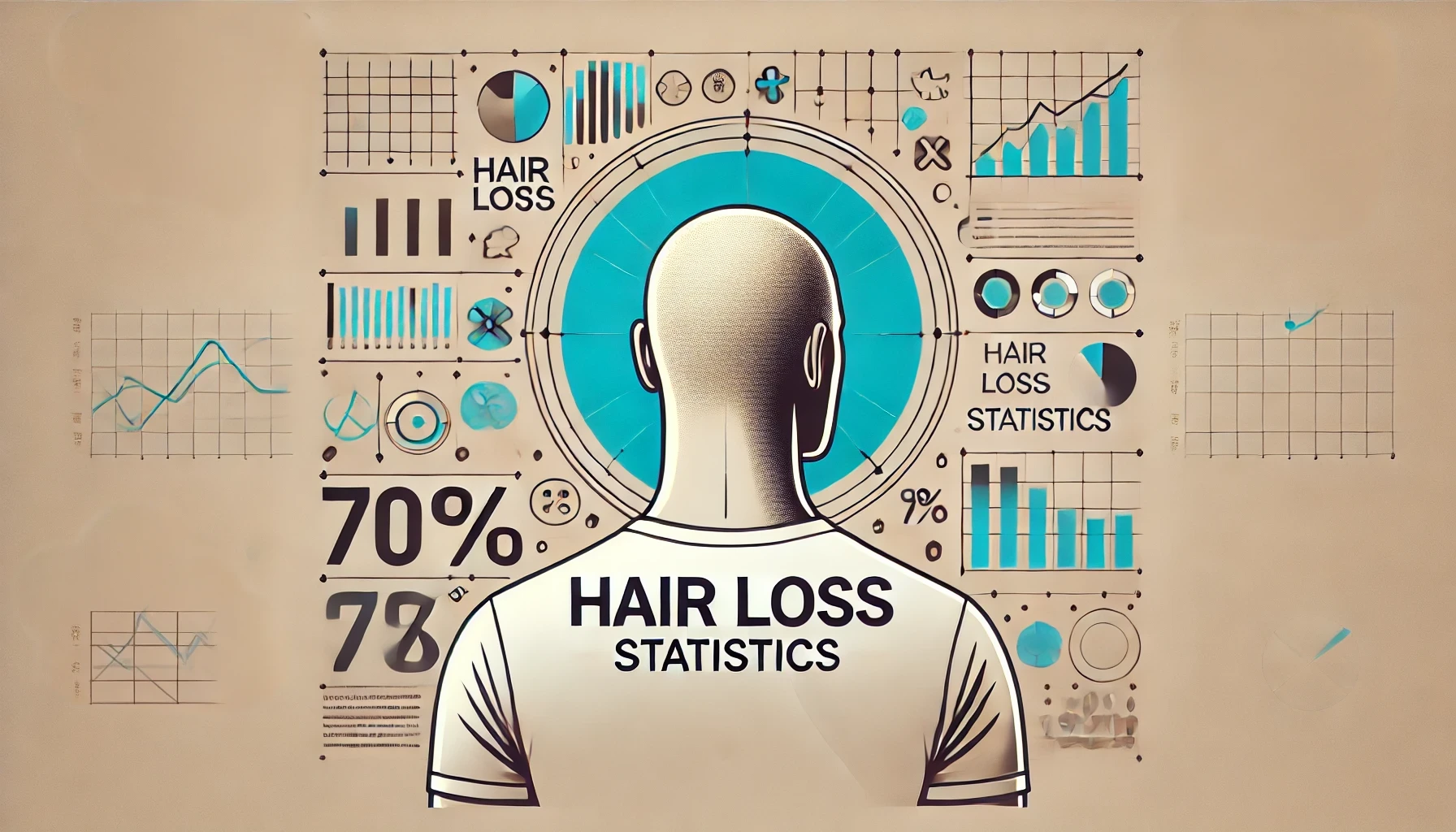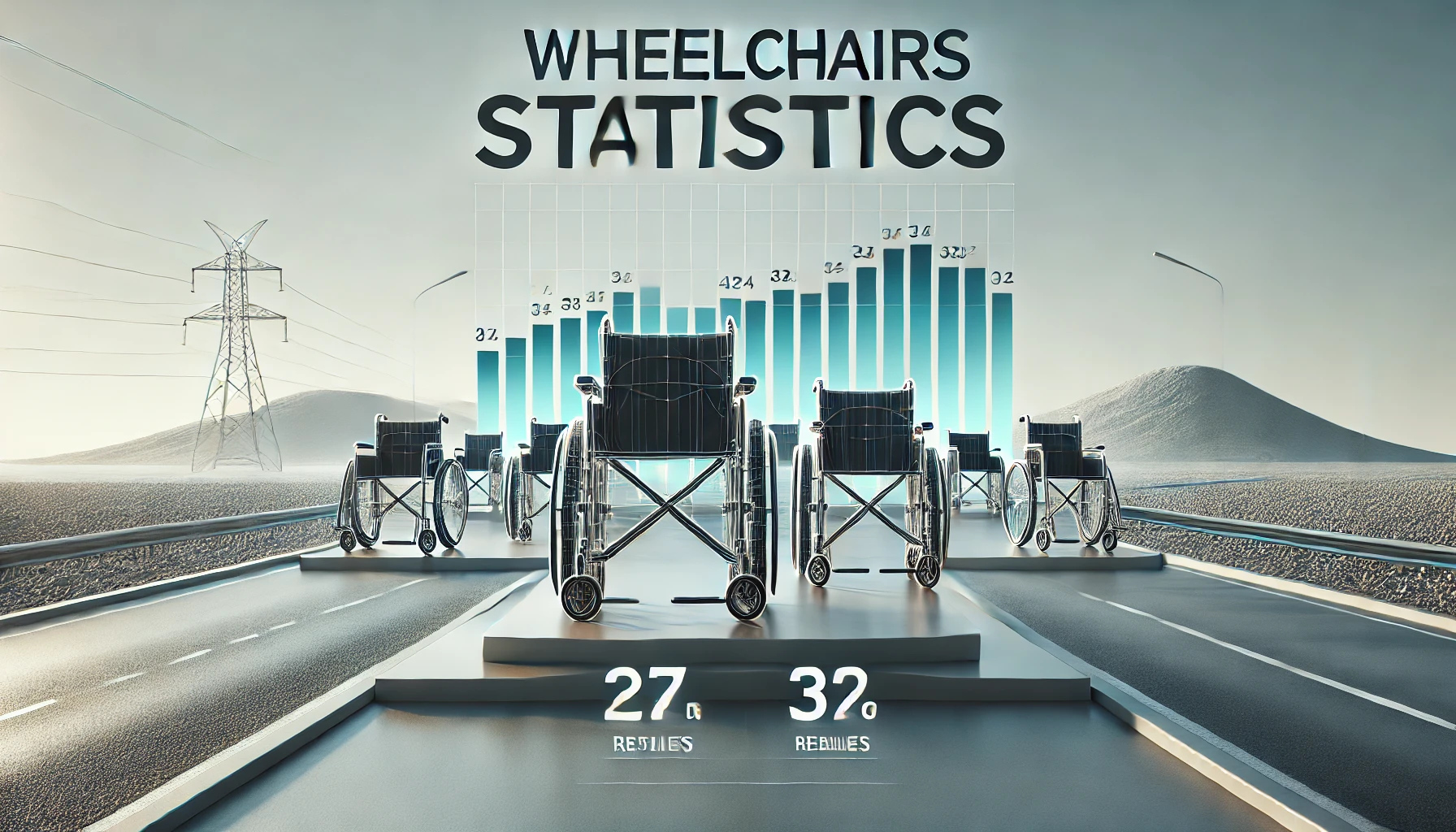Hair Loss Statistics 2024 By Age and Pattern
Updated · Aug 07, 2024

Table of Contents
- Introduction
- Editor’s Choice
- Hair Care Market Statistics by Region
- General Hair Loss Statistics
- Top 30 Countries With Most Bald Man
- Symptoms of Hair Loss
- Hair Loss in the Family – Androgenetic Alopecia
- Commonly Used Hair Loss Treatments.
- Duration of Beginning of Hair Loss
- Hair Loss Statistics by Pattern
- What Are The Causes of Hair Loss?
- Most Unfulfilled Hair Care Needs For Women in The USA in 2023
- Hair Transplant Therapy: A Solution for Hair Loss in Men and Women
- What is Hair Transplant Therapy?
- Advantages of Hair Transplant Therapy:
- Disadvantages of Hair Transplant Therapy:
- Hair Transplant Therapy in Men and Women
- Conclusion
Introduction
Hair Loss Statistics: Hair loss is one of the leading causes of heart disease in men. Men are more likely to suffer from hair loss or baldness than women. Hair loss is generally observed due to a healthy lifestyle and other long-term health conditions. In addition, medical therapies for cancer are also responsible for extreme hair loss. These Hair Loss Statistics show that more than 80 million men and women are currently suffering from hair loss issues. Unless it is hereditary, it can be prevented by following a healthy lifestyle.
Editor’s Choice
- The hair care market worldwide is estimated to generate revenue of $93.74 billion in 2024.
- 95% of hair loss cases are caused by common male pattern baldness or androgenetic alopecia.
- Every year, more than 800,000 individuals with hair loss problems look out for professional help.
- Hair Loss Statistics show that around 80 million men and women in the USA have hereditary hair loss problems.
- Medihair survey respondents said they use shampoos that claim to reduce hair loss, representing 32.6% of votes.
- The American hair care market 2024 is estimated to generate a revenue of $26.45 billion.
- Two-thirds of men in the USA are likely to have some degree of hair loss by the age of 35.
- After the 50s, women are likely to experience extreme hair loss caused by the postmenopause period.
- Baldness is connected to heart diseases; men with male pattern baldness are 32% more likely to have a risk of coronary heart disease.
- 43% of men said they are worried about losing an attractive personality after hair loss, while 21% said it makes them depressed.
Hair Care Market Statistics by Region
Worldwide
- The hair care market worldwide is estimated to generate revenue of $93.74 billion in 2024.
- Between 2024 and 2028, it will grow at a CAGR of 2.80%.
- In terms of global comparison, the United States is estimated to lead the market in terms of revenue by $13,600 million in the current year.
- The per-person revenue is projected to amount to $12.10.
Asia
- The Asian Haircare market is currently valued at $34.45 billion.
- It is estimated to grow at a CAGR of 2.91% between 2024 and 2028.
- The per-person revenue is expected to amount to $7.58 in the same market.
Africa
- As of today, the African hair care market is projected to generate revenue of $11.10 billion and grow at a CAGR of 5.38% between 2024 and 2028.
- Furthermore, the per-person revenue in Africa is projected to amount to $8.54 in the current year.
Australia and Oceania
- In 2024, per-person revenue in Australia and Oceania is estimated to be $31.24.
- Between 2024 and 2028, it is estimated to grow at a CAGR of 1.96%.
- In addition, as of today, it is estimated that the revenue will amount to $1.36 billion.
Americas
- The American hair care market 2024 is estimated to generate a revenue of $26.45 billion.
- Furthermore, it is projected that between 2024 and 2028, it will grow at a CAGR of 2.67%.
- The per-person revenue in a similar market is projected to amount to $26.02 in 2024.
Europe
- Currently, the European hair care market is estimated to generate a revenue of $20.38 billion.
- By the forecasted year, it will grow at a CAGR of 1.39% (2024 and 2028).
- The per-person revenue is estimated to amount to $24.15.
General Hair Loss Statistics
- According to a report by UnitedCare, native americans are more likely to experience hair loss caused by androgenetic alopecia (AGA).
- 95% of hair loss cases are caused by common male pattern baldness or androgenetic alopecia.
- 43% of men said they are worried about losing an attractive personality after hair loss, while 21% said it makes them depressed.
- People in the younger generation, who consume 70% more sugary drinks, are likely to suffer from aggressive hair loss.
- Between 30 to 40 years, 3 to 12% of women have visible hair loss patterns.
- After the 50s, women are likely to experience extreme hair loss caused by the postmenopause period.
- Hair Loss Statistics show that around 80 million men and women in the USA have hereditary hair loss problems.
- Two-thirds of men in the USA are likely to have some degree of hair loss by the age of 35.
- 50% of women are likely to experience noticeable hair loss after monthly cycles.
- 90% of people with hair loss problems are going through self-esteem issues.
- Around 21% of men start to lose their hair before they turn 21.
- Female hair loss is less common than that of men; however, as of today, female pattern hair loss has affected around 30 million American women.
- Around 12% of women are likely to experience hair loss before they turn 29.
- Hair Loss Statistics show that 50% of women and 85% of men are likely to experience hair loss (AHLA).
- 29% of women with high stress are 11 times more likely to experience extreme hair loss.
- Every year, more than 800,000 individuals with hair loss problems look out for professional help.
- In addition, baldness is connected to heart diseases; men with male pattern baldness are 32% more likely to have a risk of coronary heart disease.
Top 30 Countries With Most Bald Man
According to Hair Loss Statistics 2023, the following data represents the share of the male population with the highest baldness pattern. Overall, the percentage of baldness in men in the above-mentioned countries is more than 30%.
- Spain – 44.50%
- Italy – 44.37%
- France – 44.25%
- United States – 42.68%
- Germany – 41.51%
- Croatia – 41.32%
- Canada – 40.94%
- Czech Republic – 40.90%
- Australia – 40.80%
- Norway – 40.75%
- New Zealand – 40.19%
- United Kingdom – 40.09%
- Turkey – 40.03%
- Mexico – 39.75%
- Saudi Arabia – 39.75%
- Ireland – 38.65%
- Switzerland – 39.53%
- Russia – 38.28%
- United Arab Emirates – 38.10%
- Hungary – 37.86%
- Belgium – 36.04%
- Brazil – 35.71%
- Japan – 35.69%
- Sweden – 35.14%
- Iran – 35.03%
- Finland – 34.52%
- Greece – 34.52%
- Chile – 34.07%
- India – 34.06%
- Pakistan – 33.64%
Symptoms of Hair Loss

(Reference: medihair.com)
Hair Loss Statistics in men show that thinning hair is the leading symptom, contributing 26%. The process of hair loss starts either from the forehead or from the top of the head. M-shaped hair loss and a bunch of hair coming out while combing, persistent itchy scalp, increased hair loss, and U-shaped hair loss are other major symptoms of the same.
Hair Loss in the Family – Androgenetic Alopecia

(Source: medihair.com)
According to a survey by Medihair, 70.5% of people with hair loss problems reported having other family members suffering from hair loss as well. However, 29.5% of individuals have no family history.
Commonly Used Hair Loss Treatments.

(Reference: medihair.com)
Medihair survey respondents said they use shampoos that claim to reduce hair loss, representing 32.6% of votes. Scalp massage (13.8%), Healthy food intake to prevent hair loss (11.2%), medicine consumption (10.2%), and supplement use (7%) are other common treatments observed by people with hair loss issues.
Duration of Beginning of Hair Loss

(Reference: medihair.com)
Hair Loss Statistics show that 41.34% of people have suffered from hair loss for 5 to 10 years. 35% of individuals experience hair loss for more than ten years, while 25.66% have it for less than five years.
Hair Loss Statistics by Pattern

(Source: msdmanuals.com)
According to the MSD Manual Consumer version, there are various ways in which men experience hair loss. Hair loss starts at the temples of the top of the head and later spreads towards the back.
In terms of female hair loss, the initial hair loss is observed at the top of the head. Instead of direct hair loss, females experience major thinning of hair.
What Are The Causes of Hair Loss?
- Mental stress
- Irregular sleeping patterns
- Consumption of unhealthy food
- Hormone imbalances in women and consumption of anabolic steroids for bodybuilding
- Fungal infection
- Certain therapies, such as Chemotherapy
- Nutrition problems such as insufficient zinc and iron in the body.
- Pregnancy
- Extreme sweat
- Untidy hair
- Dandruff
- Health conditions such as thyroid anemia or vitamin deficiency
- Childbirth
- Polycystic Ovary Syndrome (PCOS)
Most Unfulfilled Hair Care Needs For Women in The USA in 2023

(Reference: statista.com)
According to Hair Loss Statistics 2023, hair shedding or loss is the leading unmet hair care need, resulting in 72%. Thinning hair and dull or lifeless hair are other unfulfilled hair needs by 66% and 60% of American women, respectively. In addition, graying hair and scalp conditioning are prevailing problems in American women by 50% and 23% each.
Hair Transplant Therapy: A Solution for Hair Loss in Men and Women
Hair loss can be a distressing experience for both men and women, impacting self-esteem and confidence. Fortunately, advancements in medical science have led to various treatments, with hair transplant therapy emerging as a popular option. This procedure offers hope to those seeking to restore their hairline and regain their confidence. In this article, we’ll explore the basics of hair transplant therapy, its advantages and disadvantages, and its effectiveness in both men and women.
What is Hair Transplant Therapy?
Hair transplant therapy involves surgically removing hair follicles from one part of the body, typically the back or sides of the scalp (known as the donor area), and transplanting them into areas where hair loss has occurred (recipient area). The procedure is typically performed under local anaesthesia and can take several hours to complete, depending on the extent of hair loss and the number of follicles to be transplanted.
Advantages of Hair Transplant Therapy:
- Natural Results: One of the primary advantages of hair transplant therapy is that it provides natural-looking results. The transplanted hair grows just like the surrounding hair, blending seamlessly and providing a permanent solution to hair loss.
- Permanent Solution: Unlike temporary treatments such as medications or topical solutions, hair transplant therapy offers a permanent solution to hair loss. Once the transplanted hair follicles take root, they continue to grow for the rest of the individual’s life.
- Low Maintenance: Transplanted hair requires no special maintenance or care beyond regular washing and grooming, making it a convenient option for individuals with busy lifestyles.
- Boost in Confidence: For many individuals, regaining a full head of hair can significantly boost self-confidence and improve overall quality of life.
Disadvantages of Hair Transplant Therapy:
- Cost: Hair transplant therapy can be expensive, especially if multiple sessions are required to achieve the desired results. The cost varies depending on factors such as the extent of hair loss, the clinic’s location, and the surgeon’s expertise.
- Risk of Complications: Like any surgical procedure, hair transplant therapy carries a risk of complications such as infection, scarring, or excessive bleeding. However, these risks are relatively rare when a qualified and experienced surgeon performs the procedure.
- Limited Donor Area: The success of hair transplant therapy depends on the availability of healthy hair follicles in the donor area. In some cases, individuals with extensive hair loss may have limited donor hair, making it challenging to achieve full coverage.
- Patience Required: It can take several months for the transplanted hair to grow fully and for the results to become apparent. Patience is essential, as immediate gratification is not possible with this treatment.
Hair Transplant Therapy in Men and Women
Hair loss affects both men and women, albeit in different patterns. In men, hair loss typically follows a predictable pattern known as male pattern baldness, whereas women may experience diffuse thinning throughout the scalp. Hair transplant therapy can be effective for both genders, although the approach may vary slightly.
According to Hair Transplant Statistics, hair transplant procedures have significantly increased in recent years, with men accounting for the majority of patients. However, the number of women undergoing hair transplant therapy is also on the rise as awareness of the treatment options grows.
Hair transplant therapy offers a viable solution for men and women struggling with hair loss, providing natural-looking results and a permanent solution to the problem. While the procedure comes with advantages such as natural results and increased confidence, it’s essential to consider the potential drawbacks, including cost and the risk of complications. Overall, hair transplant therapy has transformed the lives of countless individuals, restoring not only their hair but also their self-esteem and quality of life.
Conclusion
According to Hair Loss Statistics, losing 50 to 100 hairs every day is normal. However, if a bunch of hair shreds after you comb or move your hand from the head, then it is likely to be a condition of baldness or hair loss. Hair loss is the most common issue experienced by millions of people around the world. Unlike in the past decade, nowadays, extreme hair loss has become common in younger generations. Many individuals are likely to begin their hair loss after turning 20. However, following a healthy and well-maintained hair care routine will reduce such problems.

Pramod Pawar brings over a decade of SEO expertise to his role as the co-founder of 11Press and Prudour Market Research firm. A B.E. IT graduate from Shivaji University, Pramod has honed his skills in analyzing and writing about statistics pertinent to technology and science. His deep understanding of digital strategies enhances the impactful insights he provides through his work. Outside of his professional endeavors, Pramod enjoys playing cricket and delving into books across various genres, enriching his knowledge and staying inspired. His diverse experiences and interests fuel his innovative approach to statistical research and content creation.










